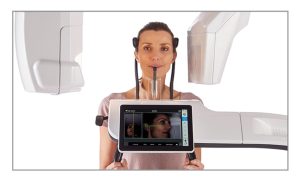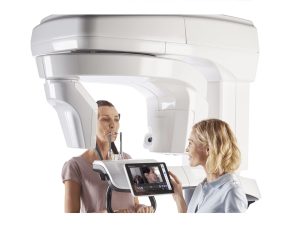When is CBCT the best option?
Featured Products Promotional FeaturesPosted by: Dental Design 25th December 2023

When offering a patient dental implant treatment, it is important to first assess their anatomy using a cone-beam computed tomography (CBCT) system. Dental radiographs have long been used as a tool in diagnosis and treatment planning, however, patients might have questions about this particular type of scan, and what they can expect in comparison to other types of imaging they may have experienced or heard of. It is important that patients are well informed about the processes needed for diagnosis and treatment planning, and that clinicians are able to answer the questions they may have. Dentists might also consider ways in which CBCT images may be used to enhance communication.
What is a CBCT scan?
Initially, medical computed tomography (CT) was used to produce 3D diagnostic images in dentistry, however, CT machines are large and deliver high doses of radiation, making them unsuitable for use in many dental settings.[i] CBCT machines, on the other hand, are more compact and use a lower dose of radiation making them the preferred option for dental applications. CBCT systems are able to produce volumetric images of both the hard and soft tissue. They were first used in the dental setting to evaluate impacted teeth, apical lesions, and mandibular and maxillary diseases.[ii] Technology has developed dramatically since the advent of this imaging type, and the systems now rotate around the patient’s head to obtain a complete set of images in a single scan which takes a matter of seconds.[iii]
It is also important to recognise the limitations when considering imaging systems. CBCT units still deliver a higher dose of radiation than some other types of imaging such as intraoral and panoramic radiographs. Because of this, CBCT scans should only be used in scenarios where the benefits outweigh the risks.[iv] Their use should always be justified, and patients must understand this before they can provide informed consent.
What makes CBCT more appropriate that other imaging types?
 In some scenarios, such as assessing the suitability for dental implants for example, CBCT is commonly the most appropriate imaging option. They can offer a highly accurate 3D view of the patient’s anatomy, using a relatively low dosage of radiation, often making them appropriate for use when reviewing treatment outcomes and peri-implant and bone health in the long-term. They are able to deliver improved image quality and accuracy compared to other imaging types, offer clinicians comprehensive information about their patient’s oral health, and deliver a quick and comfortable option.
In some scenarios, such as assessing the suitability for dental implants for example, CBCT is commonly the most appropriate imaging option. They can offer a highly accurate 3D view of the patient’s anatomy, using a relatively low dosage of radiation, often making them appropriate for use when reviewing treatment outcomes and peri-implant and bone health in the long-term. They are able to deliver improved image quality and accuracy compared to other imaging types, offer clinicians comprehensive information about their patient’s oral health, and deliver a quick and comfortable option.
CBCT imaging is a great way to obtain accurate measurements, identify any issues in the gingival tissue, detect lesions which indicate disease, locate origin of pain, and evaluate key anatomical features such as sinuses, nasal cavity, and nerve canal in preparation for surgery.[v] By assessing all of these key areas, clinicians are able to assess a patient’s suitability for treatments such as dental implants and allow them to select the correct size and length of implant to achieve optimal stability and osseointegration. They also provide a highly accurate depiction of the patient’s existing bite, allowing the dental team to plan the alignment of the final restoration to avoid malocclusion.
Enhanced patient experiences
When receiving a CBCT scan, it’s important that patients know what to expect, to help them prepare and optimise results. While the scan will usually only last a few seconds, patients who are anxious about small spaces may find the experience a little uncomfortable. Because of this, clinicians should offer personal advice to each individual. Patients must stay still for the scan, avoiding talking, swallowing, and moving the head if possible. This is because movement during the scan can cause blurred images, which can render them unusable in diagnosis and treatment planning. Therefore, it’s important that patients remain still to avoid the need for re-takes.
the experience a little uncomfortable. Because of this, clinicians should offer personal advice to each individual. Patients must stay still for the scan, avoiding talking, swallowing, and moving the head if possible. This is because movement during the scan can cause blurred images, which can render them unusable in diagnosis and treatment planning. Therefore, it’s important that patients remain still to avoid the need for re-takes.
CBCT scans also offer patients the benefits of improved communication. Because the resulting images are of such high-quality and accuracy, clinicians can use them as a visual tool to describe the patient’s situation, including any areas of concern, and the planned treatment. This is a highly effective way of improving a patient’s understanding of their own oral health and helping them to provide informed consent.
The five-time winner of the Cellerant Best of Class Technology award, the CS 9600 CBCT system from Carestream Dental is the innovative 5-in-1 scanner that drives precision in each exam. Featuring AI powered positioning, obtaining accurate and repeatable CBCT images is easier than ever. With 14 fields of view and the optional Scan Ceph module the CS 9600 CBCT system is suitable for a wide range of clinical scenarios.
CBCT imaging is a crucial tool for diagnosis and treatment planning across a number of clinical scenarios. By offering patients the accurate and detailed information they need to understand this type of imaging, and the treatment they need, they are able to provide informed consent and gain a better understanding of their own oral health.
For more information on Carestream Dental visit www.carestreamdental.co.uk
For the latest news and updates, follow us on Facebook and Instagram @carestreamdental.uk
Nimisha Nariapara
Bio
Nimisha is the Trade Marketing Manager at Carestream Dental covering the UK, Middle East, Nordics, South Africa, Russia and CIS regions. She has worked at Carestream Dental for the past 7 years, where she has developed her marketing skills and industry knowledge to bring the core values and philosophy of the company to the market.
[i] Bromberg N, Brizuela M. Dental Cone Beam Computed Tomography. [Updated 2023 Apr 19]. In: StatPearls [Internet]. Treasure Island (FL): StatPearls Publishing; 2023 Jan-. Available from: https://www.ncbi.nlm.nih.gov/books/NBK592390/
[ii] Bromberg N, Brizuela M. Dental Cone Beam Computed Tomography. [Updated 2023 Apr 19]. In: StatPearls [Internet]. Treasure Island (FL): StatPearls Publishing; 2023 Jan-. Available from: https://www.ncbi.nlm.nih.gov/books/NBK592390/
[iii] Bromberg N, Brizuela M. Dental Cone Beam Computed Tomography. [Updated 2023 Apr 19]. In: StatPearls [Internet]. Treasure Island (FL): StatPearls Publishing; 2023 Jan-. Available from: https://www.ncbi.nlm.nih.gov/books/NBK592390/
[iv] Bromberg N, Brizuela M. Dental Cone Beam Computed Tomography. [Updated 2023 Apr 19]. In: StatPearls [Internet]. Treasure Island (FL): StatPearls Publishing; 2023 Jan-. Available from: https://www.ncbi.nlm.nih.gov/books/NBK592390/
[v] Atlanta Center for Advanced Periodontics. Dental CBCT Scan: What Is It & Why You Need One. Accessed Sept 23: https://advancedperioatl.com/cbct-scan-dentist-vs-x-rays/










